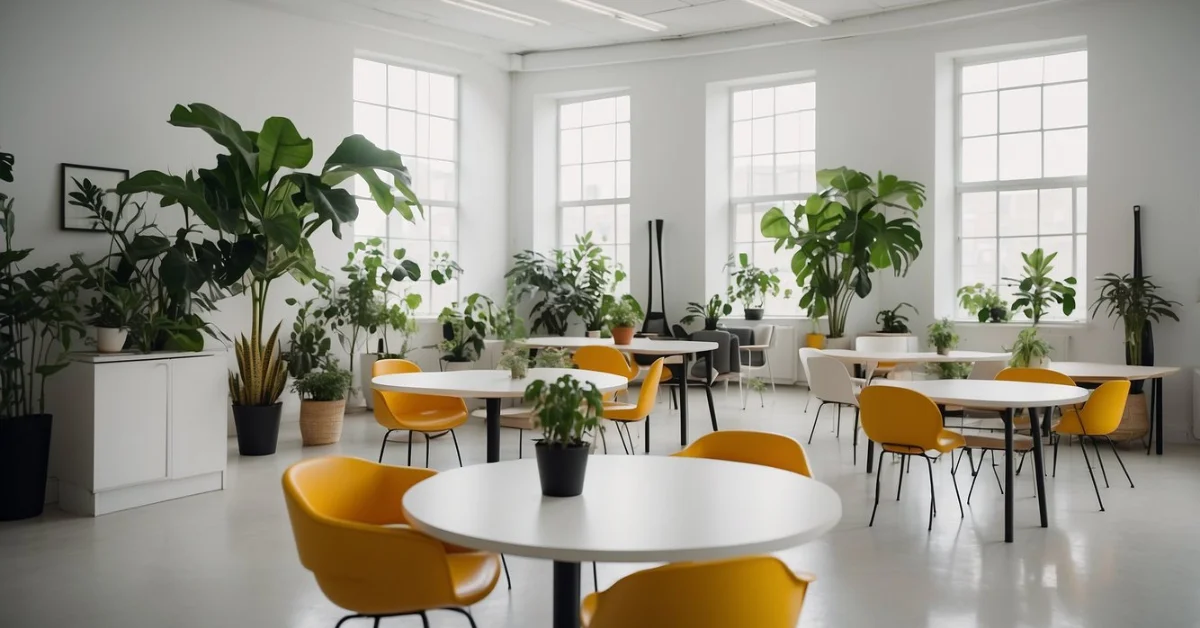In recent years, the concept of minimalism has found its place within the confines of the classroom, transforming educational spaces into environments that champion simplicity and focus.
A minimalist classroom strips away the non-essential, clutter-free decor, and centers on functionality, thus promoting a setting conducive to learning and productivity. It is not just about having fewer items in the classroom; it’s about creating a space that enhances student engagement and reduces distractions. By carefully selecting items that serve a purpose and complement the learning process, we create an atmosphere that supports students’ educational journey
This approach to decor is not only aesthetically pleasing but also serves a practical purpose. By embracing minimalism, we focus on organizing tools and resources in a way that is accessible and efficient, ensuring that every element has a clear function. Incorporating elements of nature and providing a layout that facilitates optimal learning are key aspects of minimalist classroom decor.
This strategy extends to the selection of educational resources, their arrangement within the space, and how they can be seamlessly integrated without causing visual or cognitive overload.
Personal touches are not forsaken in a minimalist classroom. Instead, they are thoughtfully incorporated to add warmth and a sense of ownership without overwhelming the space. Over time, maintaining and evolving the decor to keep the classroom functional and inviting requires a systematic approach.
Our resources for teachers interested in adopting minimalism are plentiful, offering guidance to ensure that the transition to a minimalist classroom is both impactful and enduring.
Key Takeaways
- Minimalist classroom decor supports focus and reduces distractions with purposeful design.
- Efficient organization and the inclusion of nature are central to creating calming learning spaces.
- Personalization within minimalism involves intentional choices that maintain simplicity and function.
Understanding Minimalism in the Classroom
In this section, we unravel the core values of minimalist classroom decor and explore its impact on the learning environment. Our focus is on creating a space where simplicity and functionality enhance educational outcomes.
The Philosophy of Minimalist Classroom Decor
We advocate for minimalist classroom decor, grounded in the belief that less is more. This philosophy revolves around the idea of stripping away the non-essential elements to create a learning environment free from distractions. Our minimalist classrooms involve:
- Essentials-First Approach: A careful selection of furniture and teaching aids that serve the fundamental educational needs without cluttering the space.
- Functional Design: Organizing the available space to maximize efficiency, using simple storage solutions and versatile furniture that serves multiple purposes.
Benefits of a Minimalist Approach for Students
Adopting a minimalist approach in classroom design offers several benefits that significantly enhance the learning experience:
- Increased Focus: By minimizing visual clutter, we ensure that students’ attention is directed to key learning materials and activities.
- Enhanced Well-being: A well-organized, clutter-free space can reduce anxiety and create a calm atmosphere that is conducive to learning.
| Benefit | Description |
|---|---|
| Clean Visual Lines | Promotes a distraction-free environment, aiding concentration and focus on lesson content. |
| Promotes Ownership | Encourages students to take responsibility for maintaining the organized, minimal space. |
| Adaptability | Simplifies reconfiguration for various activities, suiting diverse learning and teaching styles. |
We understand that adopting minimalist classroom decor is more than an aesthetic choice; it’s a strategic decision aimed at enhancing educational experiences.
Essential Elements of Minimalist Classroom Decor
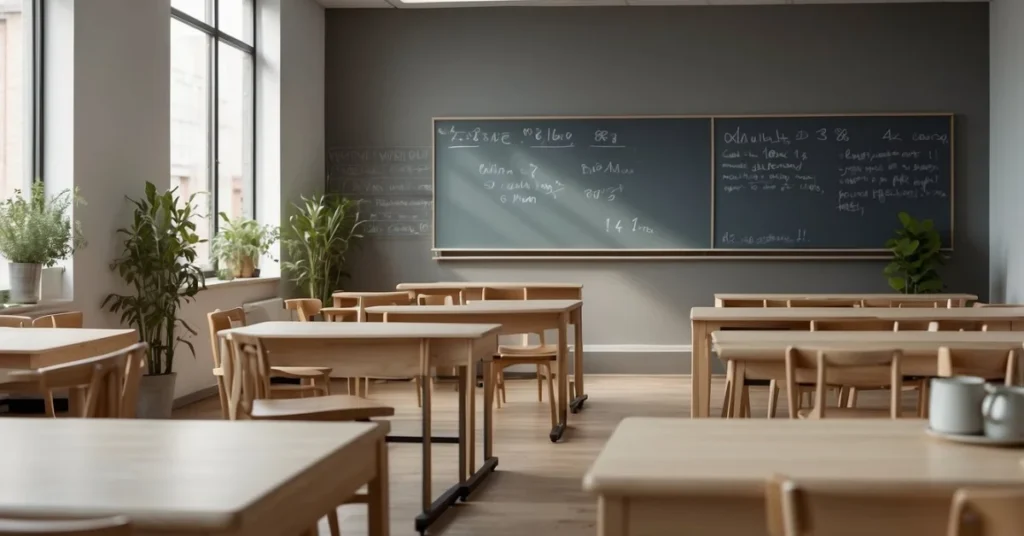
To create a minimalist classroom, we focus on a design that is functional, soothing, and free of clutter. This approach not only enhances the aesthetics of the learning space but also supports better concentration and reduces distractions for students.
Color Scheme and Visual Harmony
The color palette of a minimalist classroom decor should be cohesive and calming. Using a neutral color base, such as whites, beiges, or light grays, sets a serene backdrop. Accents can be introduced with pastel tones or a single brighter color to add a touch of interest without overwhelming the senses.
- Base Colors:
- White
- Beige
- Light Gray
- Accent Colors (choose one main accent):
- Pastel Blue
- Soft Green
- Muted Yellow
Functional Furniture Choices
We ensure that every piece of furniture serves a purpose to avoid clutter and maintain an organized environment. Desks and chairs should be comfortable and ergonomically designed to support students’ posture. Storage units must be minimalist in design and provide ample space to keep materials out of sight yet easily accessible.
- Essential Classroom Furniture:
- Desks: Simple lines, no frills
- Chairs: Ergonomic design
- Storage: Clean, seamless units
Maximizing Natural Light
Emphasizing natural light is paramount in a minimalist classroom decor. We arrange furniture to take advantage of windows and avoid heavy drapery that could block light. Mirrors or reflective surfaces can be used strategically to enhance light distribution throughout the classroom.
- Strategies to Enhance Natural Light:
- Position desks near windows.
- Use sheer window treatments.
- Incorporate mirrors to reflect light.
Decorative Strategies to Reduce Distraction
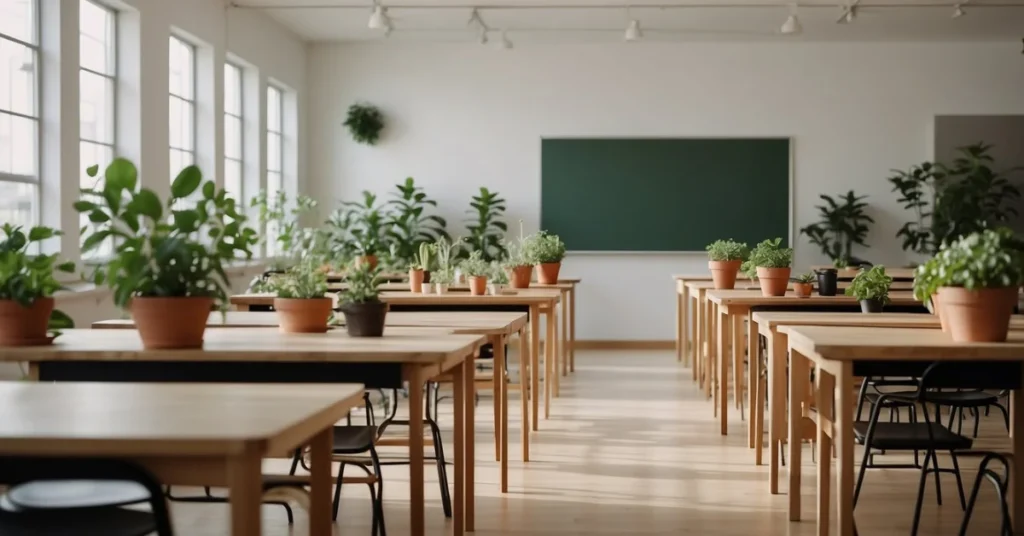
In our pursuit of a focused learning environment, we consider the physical space an integral part of education. Our approach minimizes distractions through purposeful decoration and organization.
Effective Use of Space and Decluttering Techniques
To optimize our learning environments, we employ specific decluttering techniques. We prioritize functionality over quantity, ensuring that only essential items are present. This involves:
- Regular evaluation of items: We assess each object’s relevance to educational goals.
- Furniture arrangement: We arrange desks and shelves to facilitate free movement and prevent crowdedness.
By maintaining an uncluttered space, we reduce visual noise that can detract from the learning experience.
Choosing Appropriate Artwork and Posters
Our selection of artwork and posters is intentional, aligning with educational objectives. We adhere to the following criteria:
- Relevance: We choose images that support the subject matter being taught.
- Simplicity: We opt for artwork that isn’t overly complex, minimizing distraction.
Here is an example of how we might select and position posters:
| Location | Content | Reasoning |
|---|---|---|
| Front of the classroom | Inspirational quotes | To motivate without causing distraction |
| Near resource areas | Educational diagrams | To provide visual aids that reinforce learning |
By carefully selecting posters and artwork, we foster an environment conducive to concentration and learning.
Organizational Tools for a Minimalist Classroom Decor
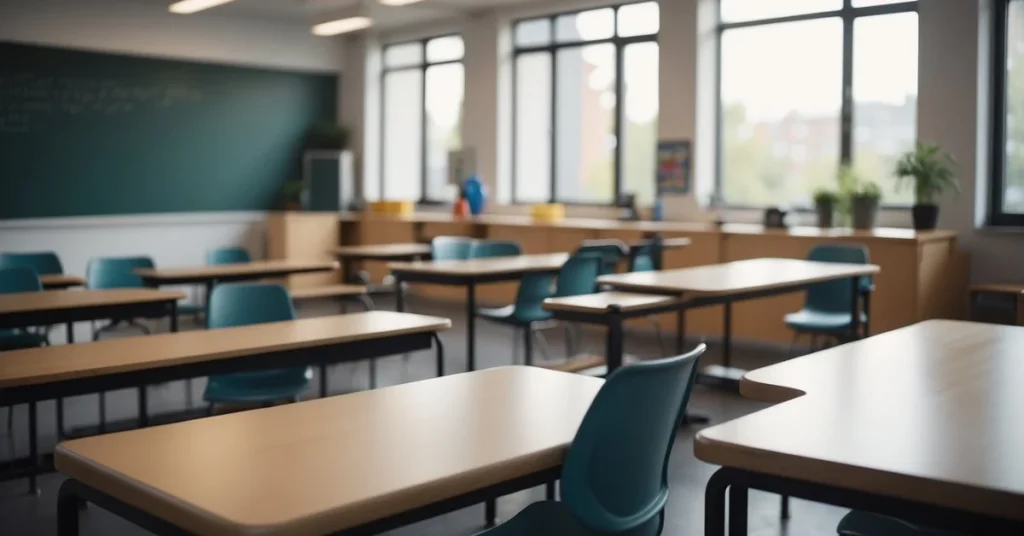
In our minimalist classroom, we focus on simplicity and functionality in our organizational tools. By optimizing labeling, storage, and utilizing bulletin boards efficiently, we keep our materials minimal and accessible.
Labeling and Storage Solutions
We streamline our classroom with clearly labeled storage solutions. Using labels on bins and shelves simplifies the search for materials. It’s important that every binder is neatly labeled and categorized to avoid clutter. We often bundleresources into themed sets, making it easier for us to find what we need and maintain order.
| Storage Type | Description |
|---|---|
| Bins | Used for grouping similar items. |
| Shelves | Keep binders and bundles accessible. |
| Drawers | Ideal for smaller, frequently used items. |
Bulletin Board Utilization
Our bulletin board is a multipurpose tool. It serves as an ever-changing word wall where we display key vocabulary, which is regularly updated to align with our lessons. By allocating sections for announcements, schedules, and student work, the bulletin board acts as a central hub without excessive decoration. We ensure that it’s functional and contributes to the learning environment without overwhelming the space.
Minimizing Teaching Materials
We aim to reduce the number of physical teaching materials in our classroom. This includes digitizing resources when possible and sharing materials among educators to avoid duplicates. Our goal is to keep only what we truly need, ensuring that every item in our classroom serves a purpose and supports our teaching objectives. Our minimalist approach not only makes our space more organized but also more focused and conducive to learning.
Incorporating Nature and Calmness
We understand the profound impact that a minimalist classroom decor can have on learning. Incorporating elements of nature and fostering a sense of calmness are key to creating a space conducive to focus and tranquility.
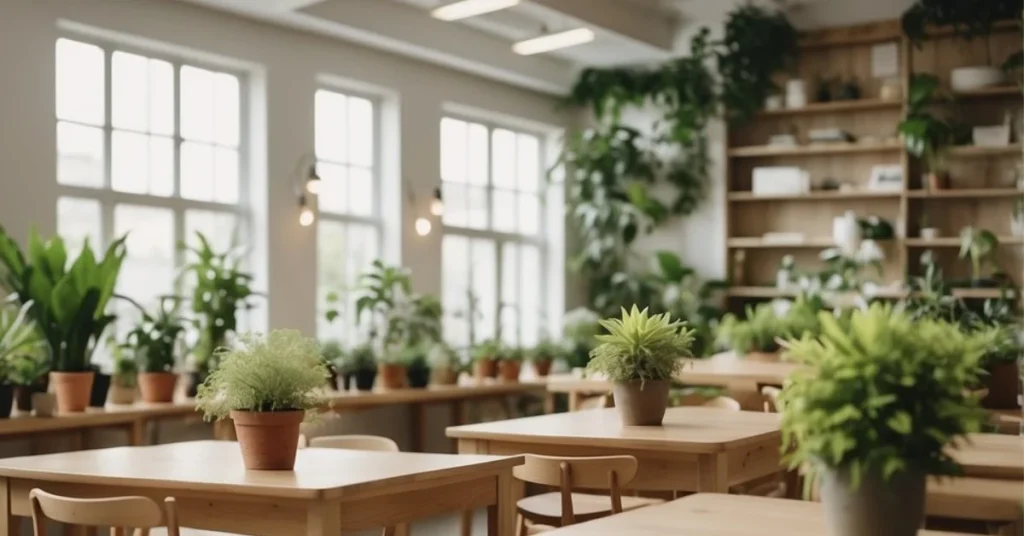
Utilizing Plants and Natural Elements
We choose plants that thrive indoors to introduce a natural, living element to our classroom. A simple table justifies our selection:
| Plant Type | Light Needs | Maintenance | Benefits |
|---|---|---|---|
| Snake Plant | Low | Low | Air-purifying |
| Spider Plant | Moderate | Low | Resilient and adaptable |
| ZZ Plant | Low | Low | Drought-tolerant |
In addition to plants, we incorporate natural materials such as wooden furniture, cotton rugs, and stone decorations. These elements bring a piece of nature into our space, supporting our nature theme and enhancing the overall calming effect.
Creating a Calming and Inviting Atmosphere
It’s our aim to create an atmosphere that not only invites calmness but also stimulates the mind gently. To do so, we focus on:
- Color palette: Soft earth tones and pastel greens which evoke a natural, calming feeling.
- Lighting: Utilization of natural light whenever possible, complemented by warm, non-fluorescent lights.
- Layout: Open spaces with unobstructed views to our natural elements, allowing free movement and promoting a relaxed environment.
By prioritizing minimalism and natural beauty, a serene and conducive learning environment emerges, rooted in simplicity and poise.
Classroom Layout for Optimal Learning
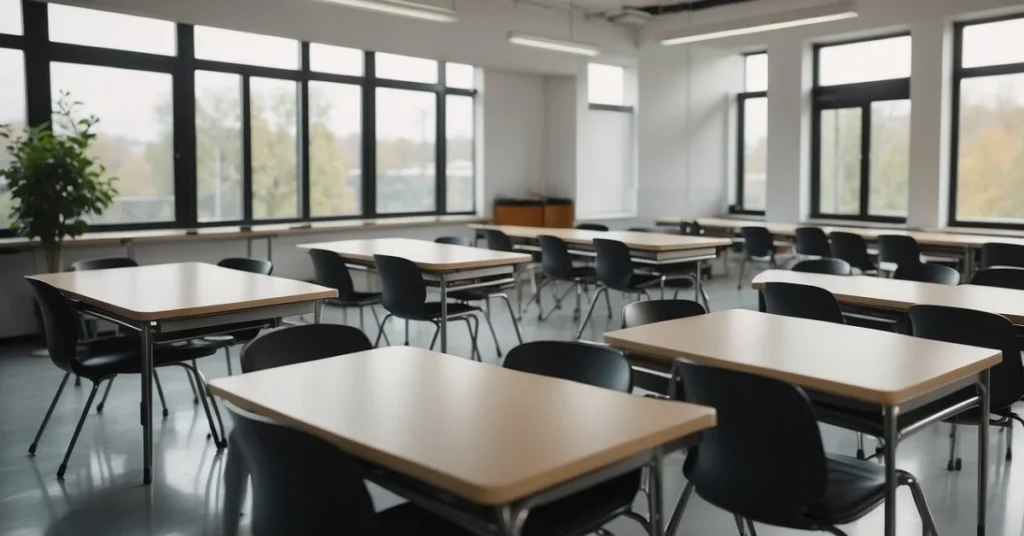
In establishing a minimalist classroom, we focus on creating an environment that promotes attention and engagement. Our layout is clean and purposeful, designed to facilitate seamless learning and teaching.
Flexible Seating Arrangements
We incorporate flexible seating to support student choice and comfort. This includes a variety of options such as:
- Bean bags: For casual reading or group discussions.
- Standing desks: To accommodate different learning styles and promote movement.
- Traditional chairs and desks: Arranged in a horseshoe or circle for focus and inclusivity.
We ensure that seating can be easily reconfigured for individual activities, collaborative projects, or whole-class instruction.
Designing Functional Learning Zones
Our minimalistic approach extends to learning zones within the classroom. We carefully consider each area’s purpose and equip it with just the essentials to support the activities intended for the space.
- Reading Nook: A quiet corner with a comfortable seating option and low shelves stocked with a variety of books. Visibility is key, and decorations are kept to a minimum to reduce distractions.
- Interactive Whiteboard Area: A technological focal point for digital learning and displaying student work. This zone is fluid, allowing students to move up for closer interaction or to present their findings.
- Individual Workspaces: Simple, clutter-free desks with ample space for students to spread out materials and focus on individual tasks.
- Group Collaboration Tables: Larger tables to facilitate learning space for teamwork with necessary supplies stored in central, shared containers.
By maintaining a minimalist decor, we enhance our classroom’s functionality, ensuring it remains a dynamic, focused, and adaptable learning environment.
Educational Resources within Minimalist Decor
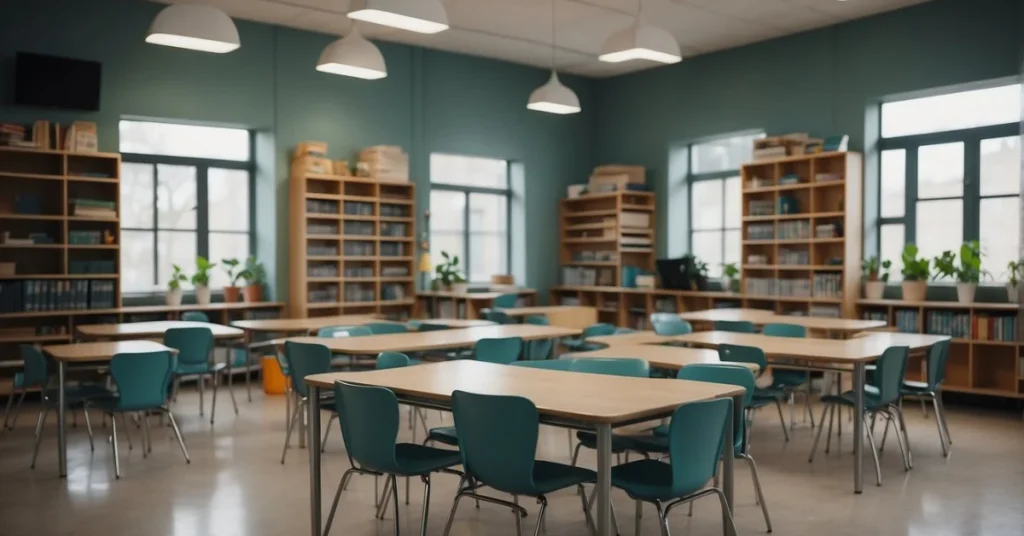
In our minimalist classroom decor, we focus on incorporating educational resources that enhance learning without overwhelming the space.
Implementing Anchor Charts and Educational Posters
We select anchor charts that support current learning objectives. These charts contain key information and concepts related to the lesson at hand. Our anchor charts are usually designed with:
- Simplicity: Bold headings with concise explanations or examples.
- High Contrast: Black or dark text on a white or light background for readability.
- Emphasis on Core Concepts: Only the most crucial elements to avoid clutter.
When it comes to educational posters, such as alphabet posters or number lines, we follow similar principles:
- Clarity: Lettering and numbers are clear, easy to read, and appropriately sized.
- Relevance: Posters are relevant to the students’ current learning stage.
- Consistency: The design aligns with the minimalist aesthetic of the classroom.
Curating a Student-Centered Space
To create a student-centered space, we exhibit student work in a way that contributes to the minimalist decor while recognizing students’ achievements. Our approach includes:
- Selective Display: Showcasing exemplary work that aligns with the lesson theme.
- Rotating Exhibits: Regularly updating the displayed work to keep the environment fresh and relevant.
- Uncluttered Layout: Arranging student work with ample space between each piece to ensure each work stands out on its own merit.
By carefully selecting and displaying educational resources and student work, we craft an environment that is both functional and minimalist.
Personalizing Your Minimalist Classroom
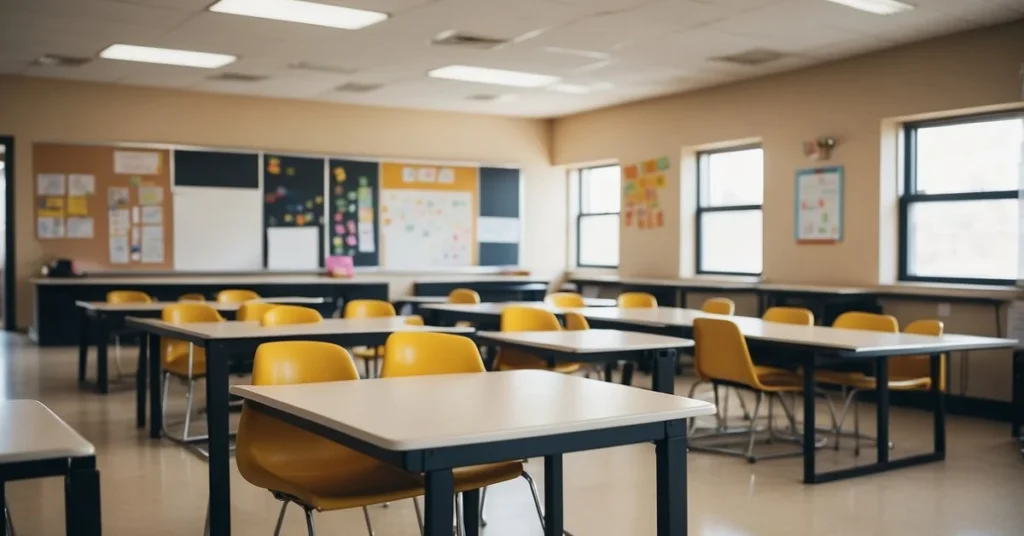
In our minimalist classroom, we know the importance of creating a space that feels both personalized and inviting. We aim to reflect our students’ identities and achievements without cluttering the environment.
Student-Created Decor and Displays
Student Work: Displaying student work is an impactful way to personalize our classroom. We use simple, uniform frames or clipboards mounted on the walls to showcase essays, art, and projects. This approach not only celebrates students’ efforts but also maintains a minimalist aesthetic.
Birthday Display: A minimalist birthday display can be both fun and low-profile. We choose a dedicated space on a bulletin board and update it monthly. Utilizing magnetic letters and a simple printed calendar, we highlight each student’s special day without excess decoration.
Minimalist Theme Variations
Mix and Match: Personalizing our space doesn’t mean abandoning our minimalist principles. We carefully select a few key colors and patterns for items like cushions and rugs, ensuring they complement each other and can be easily swapped out for a fresh look throughout the year.
Personalization: In a minimalist classroom, every element serves a purpose. From seating choices to storage, we assess each item for both function and form. A curated selection of posters with inspirational quotes or educational material provides a personal touch while supporting our educational goals.
Maintenance and Evolution of Decor
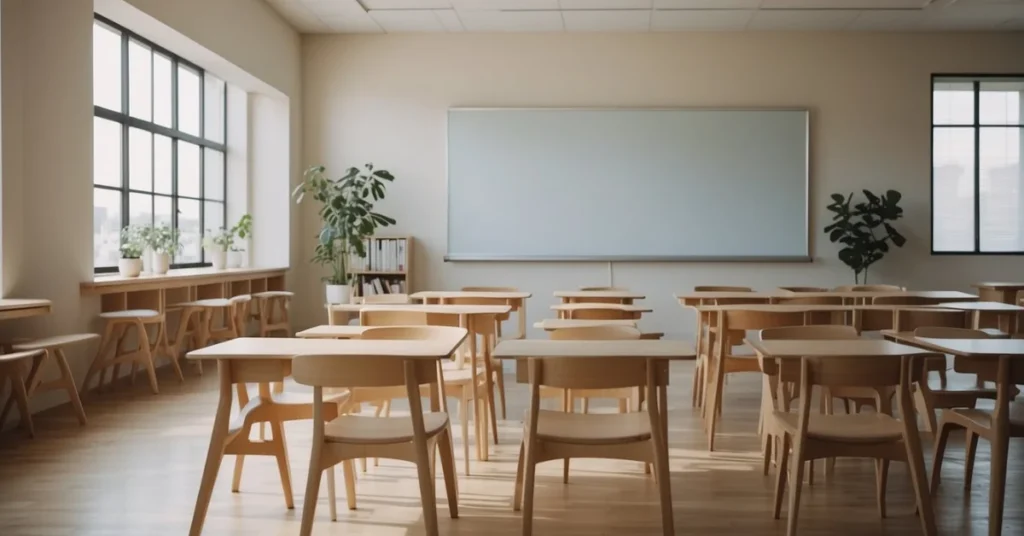
Maintaining a minimalist classroom decor requires routine care, while evolution involves thoughtful updates. Our goal is to create a space that is easy to manage and regularly rejuvenated to avoid stagnation.
Routine for Updating and Refreshing Classroom Decor
We schedule updates for our minimalist classroom decor regularly to keep the environment dynamic yet simple. Twice a year, we assess our space and decide if any item needs replacement. Below is the typical routine we follow to refresh our decor:
- Assessment: Every six months, we review the classroom’s visual appeal and functionality.
- Evaluate Current Items: Check each decor item for wear and relevance.
- List Replacement Needs: Note any items that require updating due to damage or educational changes.
- Implementation: Following assessment, we plan for the replacement and refreshing of items.
- Select New Decor: Choose replacement items that align with our minimalist aesthetic and educational goals.
- Install: Add new items to the classroom, ensuring they serve a clear purpose and contribute positively to the learning environment.
Strategies for Avoiding Visual and Physical Clutter
To prevent clutter, we adhere to strategies that help maintain a minimalist classroom:
- Regular Decluttering: Once a month, we take time to de-clutter. Any item not essential to our daily activities or learning objectives is removed.
- Clear Surfaces: Keep flat surfaces free of unnecessary items to maintain a clean, open look.
- Streamlined Storage: Optimize storage solutions to keep materials out of sight but organized and accessible.
- Conscious Acquisition: Before introducing a new item into the classroom, we consider its necessity and function.
- Function Over Form: Any new decor must have a clear functional benefit or support the educational experience.
- Quality Over Quantity: Invest in durable and timeless pieces that will not need to be replaced frequently due to wear or changing trends.
By following these guidelines, we ensure that our space never becomes overwhelming or resembles that of a hoarder. Through conscientious maintenance and thoughtful updates, we manage to keep our classroom decor both aesthetically pleasing and conducive to learning.
Teacher Resources for a Minimalist Classroom Decor
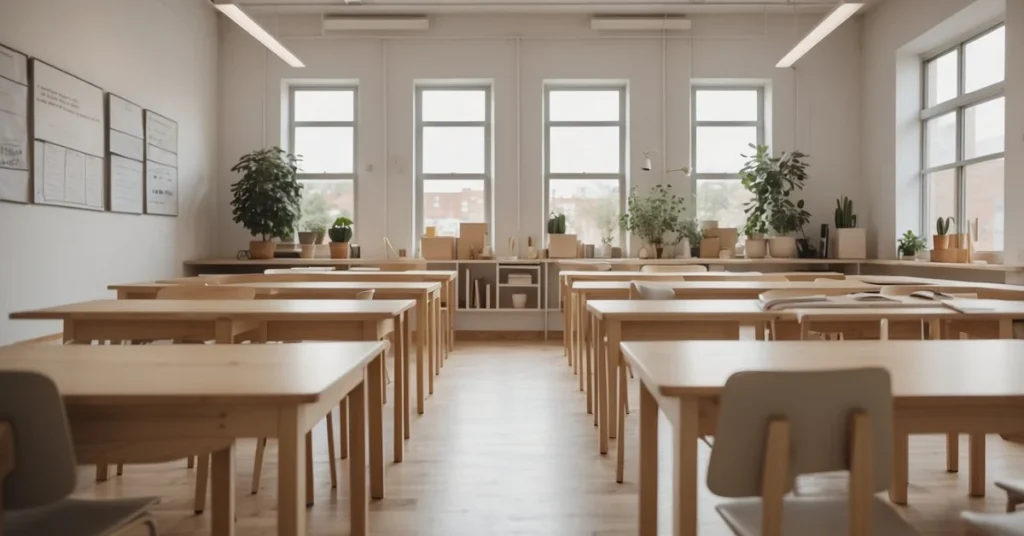
In creating a minimalist classroom, we focus on simplicity and utility, ensuring that every decor piece serves a purpose. We curate resources carefully to support educators in maintaining a clutter-free environment conducive to learning.
Finding and Editing Minimalist Decor Products
To select minimalist decor products, we recommend starting with basic functional items. We can find these at select retailers known for their clean and simple designs. For editing existing materials, consider these steps:
- Evaluate: Look at each item and decide if it’s necessary for educational purposes.
- Simplify: Remove or replace any item that doesn’t align with the minimalist aesthetic.
- Repurpose: Find new, inventive ways to use items that are already part of the classroom setup.
Tip: Resources like free online marketplaces can be an ideal place to check out to rehome or acquire second-hand minimalist items, which helps to reduce waste and cost.
Educator Communities and Support
For support and ideas, we should join educator communities specializing in minimalist approaches. These online forums and social media groups share advice and product recommendations tailored to minimalism in education. To make the most of these communities:
- Use hashtags like #MinimalistTeacher or #SimpleClassroom to find relevant conversations.
- Reach out to experienced minimalist teachers for personalized guidance and mentorship.
By staying connected with these communities, we enhance our approach and collective knowledge, ensuring our minimalist classroom decor remain effective and welcoming learning spaces.
Frequently Asked Questions
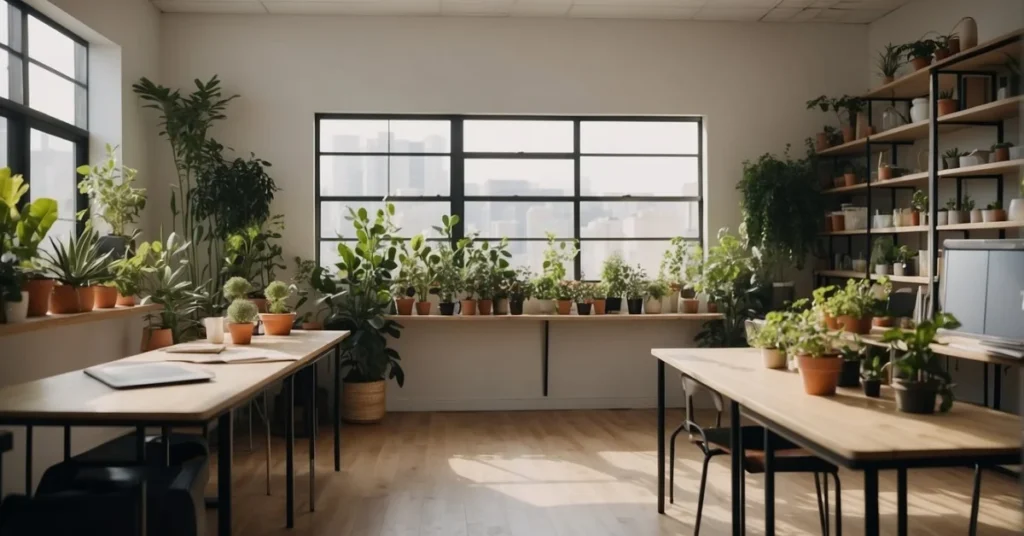
Minimalist decor in a classroom prioritizes openness and simplicity, enhancing the focus and functionality of the learning environment. Our approach to decoration balances aesthetics with practicality, ensuring that each element serves a purpose.
What are essential elements when creating a minimalist classroom decor?
When designing a minimalist classroom decor, essential elements include functional furniture, neutral color palettes, and clutter-free surfaces. We focus on high-quality, multipurpose pieces that support a variety of teaching methods and learning styles.
How can a teacher achieve a cozy atmosphere in a classroom with minimalist design?
To create a cozy atmosphere within a minimalist design, we incorporate soft lighting, comfortable seating options, and natural elements like plants. These features can maintain a warm and inviting space without excess decor.
What strategies can a minimalist teacher use to maximize space in a small classroom?
Maximizing space in a small classroom involves using vertical storage solutions, such as wall-mounted shelves, and choosing furniture that can be easily reconfigured for different activities. Our approach also includes regular decluttering to maintain an open and airy feel.
What are some practical minimalist decorating ideas for high school classrooms?
For high school classrooms, practical minimalist decorating ideas include using functional decor like whiteboards or cork boards, displaying only essential instructional materials, and implementing a streamlined layout that encourages orderly student movement and interaction.
How can minimalist classroom decor impact student learning and focus in a minimalist environment?
Classroom decor in a minimalist environment can enhance student learning and focus by reducing visual distractions. We strive for an organized setting where everything has its place, allowing students to direct their attention solely toward the lesson at hand.
Where can educators find inspiration for minimalist classroom posters and visuals?
Educators can find inspiration for minimalist classroom decor like posters and visuals from educational blogs, design websites, or platforms like Pinterest that offer a wealth of resources for simplistic yet impactful classroom visuals. We select resources that are not only visually appealing but also support curriculum goals.
We’ve explored the world of Minimalist Classroom Decor and how it can transform learning spaces.
Now, we invite you to be a part of this journey. Do you have your own experiences or innovative ideas for minimalist classroom decor? Your insights matter to us, and we’d love to learn from your unique perspective.
Share your thoughts, tips, and questions in the comments below, and let’s continue the conversation on creating inspiring and effective learning environments.

